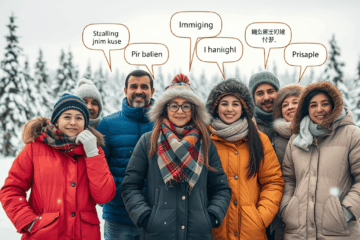Table of contents
It is important to have a checklists for what to do when you arrive in Canada to ensure a smooth transition. Here’s a comprehensive list of things to do upon your arrival:
With family

Immediate Tasks Upon Arrival
- Document Check: Ensure you have all necessary documents, like your passport, visa, and Confirmation of Permanent Residence (COPR).
- Airport Procedures: Follow airport signs for immigration and customs. Present your documents when asked.
- Welcome Kit: Collect any welcome kits or pamphlets available at the airport. They often contain useful information for newcomers.
- Currency Exchange: Exchange some money into Canadian dollars at the airport for immediate expenses.
- Transportation: Arrange transportation from the airport to your temporary accommodation.
First Few Days
- Temporary Accommodation: Check into your pre-arranged accommodation.
- Social Insurance Number (SIN): Apply for your SIN at a Service Canada office. It’s essential for working and accessing government services.
- Bank Account: Open a Canadian bank account.
- Phone and Internet: Get a local SIM card or mobile plan and set up internet services.
- Health Insurance: Register for provincial health insurance. There may be a waiting period, so consider getting private health insurance for immediate coverage.
Within the First Month
- Permanent Accommodation: Start looking for permanent housing. Research neighborhoods and visit potential homes.
- School Registration: If you have children, start the process of enrolling them in school.
- Driver’s License: Apply for a Canadian driver’s license if you plan to drive.
- Local Orientation: Familiarize yourself with local services, transportation systems, shopping centers, emergency services, and recreational facilities.
- Community Connections: Explore community centers and social groups to meet people and build a support network.
Ongoing Tasks
- Job Search: If you haven’t secured employment yet, begin your job search.
- Language Classes: If necessary, enroll in English or French language classes.
- Government Services Registration: Register for any other relevant government services or programs.
- Financial Planning: Develop a budget and start planning your finances, including savings and investments.
- Cultural Integration: Attend local events and participate in cultural activities to understand Canadian culture and integrate into the community.
Health and Safety
- Emergency Numbers: Memorize important emergency numbers (like 911) and understand when to use them.
- Medical Services: Identify nearby clinics, hospitals, and pharmacies.
- Safety Norms: Understand local laws and safety norms to ensure compliance and security.
Legal and Immigration Tasks
- Immigration Reporting: If required, report your arrival to immigration authorities.
- Legal Documentation: Keep all your legal documents in a safe and accessible place.
- Stay Informed: Keep up-to-date with any changes in immigration policies or legal requirements.
Miscellaneous
- Weather Preparedness: Understand the local weather and get appropriate clothing and supplies, especially if you’re in a region with extreme weather conditions.
- Local Networking: Connect with local professional networks and communities related to your field.
With Student Visa

Arriving in Canada as an international student involves a set of specific tasks to ensure a smooth transition into your new academic and social life. Here’s a comprehensive checklist to follow upon your arrival:
Immediate Tasks Upon Arrival
- Document Verification: Ensure you have your passport, study permit, acceptance letter from your educational institution, and any other relevant documents.
- Customs and Immigration: Complete all procedures at the airport. Present your documents to immigration officers when asked.
- Collect Welcome Kits: Many airports offer welcome kits for international students with helpful information.
- Currency Exchange: Convert some of your money into Canadian dollars for initial expenses.
- Transport to Accommodation: Arrange for transportation to your pre-arranged accommodation, whether it’s a university dorm or other housing.
First Few Days
- Check into Accommodation: Settle into your accommodation and check all the facilities.
- Campus Orientation: Participate in any orientation programs offered by your institution.
- Open a Bank Account: Choose a bank and open a student account. This is crucial for managing your finances in Canada.
- Get a Local SIM Card: Purchase a Canadian SIM card for your phone for local connectivity.
- Acquire Health Insurance: Register for the university health plan or arrange private health insurance if necessary.
Within the First Week
- Social Insurance Number (SIN): Apply for your SIN at a Service Canada office. It’s needed for working and accessing certain services.
- University Registration: Complete your university registration and get your student ID card.
- Course Enrollment: Confirm your courses and class schedule.
- Local Area Familiarization: Explore the area around your campus and accommodation. Locate essential services like grocery stores, pharmacies, and transportation links.
- Public Transportation: Understand the local public transport system. Consider getting a transit pass if available.
Settling In
- Study Permit Conditions: Familiarize yourself with the conditions of your study permit, including work eligibility.
- Meet the Academic Advisor: Schedule a meeting with your academic advisor to discuss your study plan.
- Library and Facilities Tour: Familiarize yourself with the university’s library and other facilities.
- Join Student Groups: Participate in student clubs and organizations to meet new people and integrate into campus life.
- Set a Budget: Plan your finances, considering tuition, accommodation, food, transportation, and other expenses.
Health and Safety
- Emergency Numbers and Procedures: Learn about campus safety and emergency numbers.
- Health Services on Campus: Locate health and counseling services provided by your university.
Long-term Considerations
- Work Opportunities: If you plan to work part-time, start looking for on-campus or off-campus opportunities.
- Networking and Socializing: Engage in networking events and social gatherings to build connections.
- Cultural Adaptation: Participate in cultural activities and workshops to adjust to life in Canada.
- Regular Check-ins: Keep in touch with family and friends back home.
Legal and Administrative
- Keep Documents Safe: Store all important documents in a secure place.
- Stay Informed: Keep updated with any changes in student visa regulations or university policies.
- Address Registration: If required, register your address with your home country’s embassy or consulate.
- Academic Integrity: Understand and adhere to the academic integrity and conduct policies of your university.
With Work Visa

Arriving in Canada with a work permit involves a series of steps to establish yourself both professionally and personally. Here’s a comprehensive checklist for your arrival:
Immediate Tasks Upon Arrival
- Document Verification: Ensure you have your passport, work permit, job offer letter, and other relevant documents.
- Immigration Process: Complete all procedures at the airport. Present your documents to immigration officers when requested.
- Currency Exchange: Convert a portion of your money into Canadian dollars for immediate expenses.
- Transportation: Arrange for transportation from the airport to your temporary or permanent accommodation.
First Few Days
- Temporary Accommodation: Check into your pre-arranged accommodation.
- Social Insurance Number (SIN): Apply for your SIN at a Service Canada office. This is necessary for working and accessing government services.
- Bank Account: Open a Canadian bank account to manage your finances.
- Phone and Internet: Get a local SIM card or mobile plan and set up internet services.
- Health Insurance: Register for provincial health insurance. In the interim, consider private health insurance for immediate coverage.
Settling In
- Permanent Accommodation: If you haven’t already, start looking for permanent housing.
- Meet Your Employer: Contact and meet with your employer. Confirm your start date and understand your work schedule.
- Driver’s License: If you plan to drive, apply for a Canadian driver’s license.
- Local Orientation: Familiarize yourself with the local area, including transportation, shopping centers, emergency services, and recreational facilities.
- Community Connections: Explore community centers, social groups, or professional networks to integrate into your new environment.
First Month and Beyond
- Job Start: Begin your new job. Understand your role, responsibilities, and workplace culture.
- Government Services Registration: Register for any other relevant government services or programs.
- Financial Planning: Set up a budget considering your income, living expenses, savings, and investments.
- Cultural Integration: Participate in local events and activities to understand Canadian culture and integrate into the community.
Health and Safety
- Emergency Numbers: Learn important emergency numbers and healthcare services available in your area.
- Safety Norms: Familiarize yourself with local laws and safety standards.
Legal and Immigration
- Work Permit Conditions: Ensure you understand the conditions of your work permit, including restrictions and validity.
- Legal Documentation: Keep all your legal documents in a safe and accessible place.
- Stay Informed: Keep up-to-date with any changes in work permit regulations or employment laws.
Miscellaneous
- Weather Preparedness: Understand the local climate and acquire appropriate clothing and supplies, especially in areas with extreme weather conditions.
- Networking: Engage in professional networking to build connections in your field.
- Learning and Development: Consider opportunities for further education or professional development to enhance your career prospects in Canada.
With Tourist Visa

Visiting Canada as a tourist can be an exciting experience. To ensure you make the most of your trip, here’s a comprehensive checklist to follow:
Pre-Departure
- Travel Documents: Ensure your passport is valid. Obtain a tourist visa or Electronic Travel Authorization (eTA) if required.
- Travel Insurance: Purchase travel insurance covering health, travel interruptions, and lost baggage.
- Accommodation Booking: Reserve your hotels, hostels, or Airbnb accommodations.
- Itinerary Planning: Plan your trip itinerary, including cities, attractions, and any tours.
- Transport Arrangements: Book flights, car rentals, or train tickets for intercity travel within Canada.
- Health Precautions: Get any required vaccinations and pack prescription medicines.
- Financial Preparation: Inform your bank about your travel dates, exchange some currency to Canadian dollars, and ensure your credit cards are travel-ready.
- Packing: Pack according to the Canadian weather during your visit, including appropriate clothing, footwear, chargers, and travel adaptors.
Upon Arrival
- Customs and Immigration: Complete customs and immigration formalities at the airport.
- SIM Card or Wi-Fi: Buy a Canadian SIM card or arrange for a Wi-Fi hotspot for connectivity.
- Transport to Accommodation: Use public transport, a taxi, or a rental car to reach your accommodation.
During Your Stay
- Currency Exchange: Exchange more money if needed, preferably at a bank or official currency exchange.
- Public Transportation: Familiarize yourself with the public transport system, especially in big cities.
- Attractions and Activities: Visit planned attractions. Consider purchasing city passes if available for discounts.
- Local Cuisine: Try local foods and delicacies.
- Shopping: Explore local markets and shopping centers, adhering to your budget.
- Cultural Etiquette: Be aware of and respectful toward Canadian cultural norms and etiquettes.
- Safety Precautions: Stay informed about local emergency numbers and be aware of your surroundings.
Exploring Canada
- Natural Landscapes: Visit national parks, lakes, and mountains if your itinerary allows.
- Cultural Sites: Explore museums, historical sites, and cultural landmarks.
- Local Events: Participate in local events or festivals happening during your stay.
- Photography: Capture memories with photos, but be respectful of areas where photography may be restricted.
- Eco-friendly Practices: Be mindful of the environment, dispose of waste properly, and respect wildlife.
Before Departure
- Souvenirs: Purchase souvenirs for yourself and loved ones.
- Packing for Return: Ensure all your belongings are packed, including any purchases.
- Accommodation Check-Out: Complete check-out procedures at your accommodation.
- Airport Arrival: Arrive at the airport well ahead of your departure flight.
- Customs and Duty-Free: If interested, explore duty-free shopping and be aware of customs regulations for your return.
Post-Travel
- Health Check: If you feel unwell after returning, consult a doctor, especially if visiting remote areas.
Pax Law
Explore Pax Law Blogs for In-Depth Insights on Key Canadian Legal Topics!
Discover more from Pax Law Corporation
Subscribe to get the latest posts sent to your email.



0 Comments